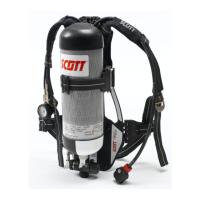PRO-PAK
4
Pro-Pak is marked in accordance with
EN 137 : 2003 and AS/NZS1716 : 2003.
An explanation of those markings is given
below:
Key Meaning
A =
Product brand name
B =
Symbol - refer to User Instructions
C =
Product model/designation
D =
Apparatus description
E =
Standards to which apparatus is certified
F =
Number of Approval Body
G =
Serial number of apparatus
H =
Date of manufacture
I =
Contact details of manufacturer
2.2 HARNESS
The Pro-Pak harness is made from
flame-retardant Kevlar
TM
and Nomex
TM
.
The buckles are manufactured from
stainless steel, chromium-plated steel or
brass; and the press-studs from brass or
nickel-plated brass.
For wearer comfort, a lumbar pad or full
back pad is provided. Both are fabricated
from flame-retardant material and packed
with flame retardant, closed cell foam.
The lumbar pad is held in place by four
press-studs. The full-length pad is held by
press studs and the harness straps.
2.3 CYLINDER BAND
Pro-Pak can be configured for use with
one or two (Duo) 200, 207 or 300 bar,
steel or fully wrapped aluminium carbon
fibre composite cylinders (see Table 3).
Cylinders are secured to the lightweight
back-plate by a webbing cylinder band
and a cylinder valve retainer (CVR).
The webbing cylinder band is secured
around the cylinder(s) by a hinged, clamp
mechanism with a thumb-operated
release tag that prevents accidental
opening. The band can be adjusted to
accept the range of cylinders listed in
Table 3. The clamp mechanism facilitates
replacement of similar size cylinders
without cylinder band adjustment.
Pro-Pak Duo cylinder bands can easily
be altered by the wearer (no tools
required) to mount a single cylinder,
centrally on the back-plate.
2.4 THE PNEUMATIC
SYSTEM
The pneumatic system has two pressure
reduction stages: air from the cylinder is
reduced to a medium-pressure (MP) of
between 5.5 and 11 bar by the reducer.
The second pressure reduction is
performed in the facemask Demand
Valve (DV).
Air from the cylinder passes through a
sintered bronze particle filter in the
cylinder connector, which protects the
pneumatic system, then through a short
length of high-pressure (HP) braided
hose to the reducer inlet manifold.

